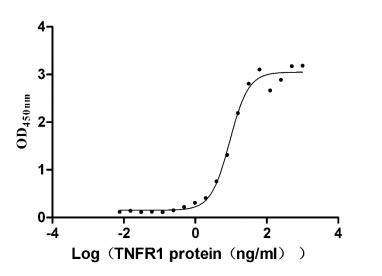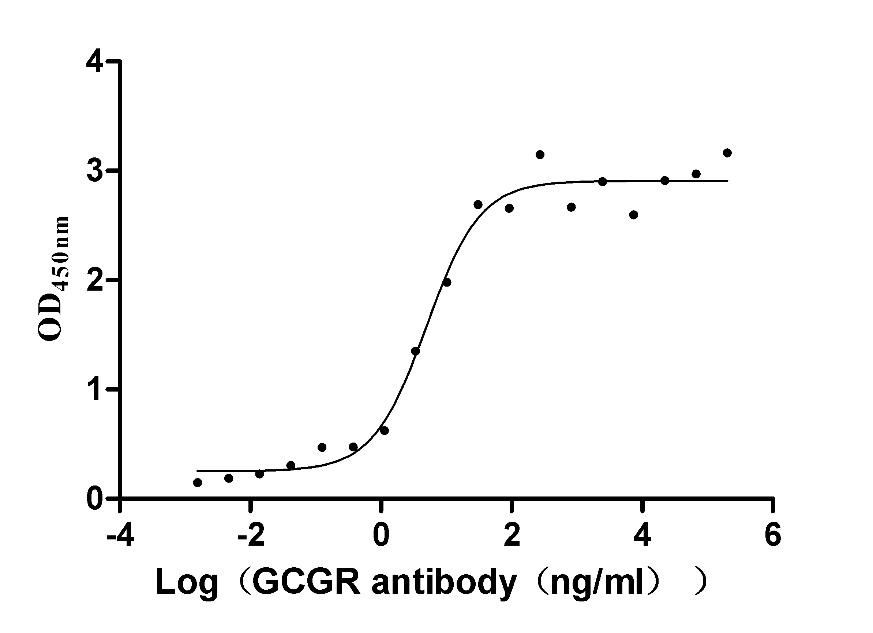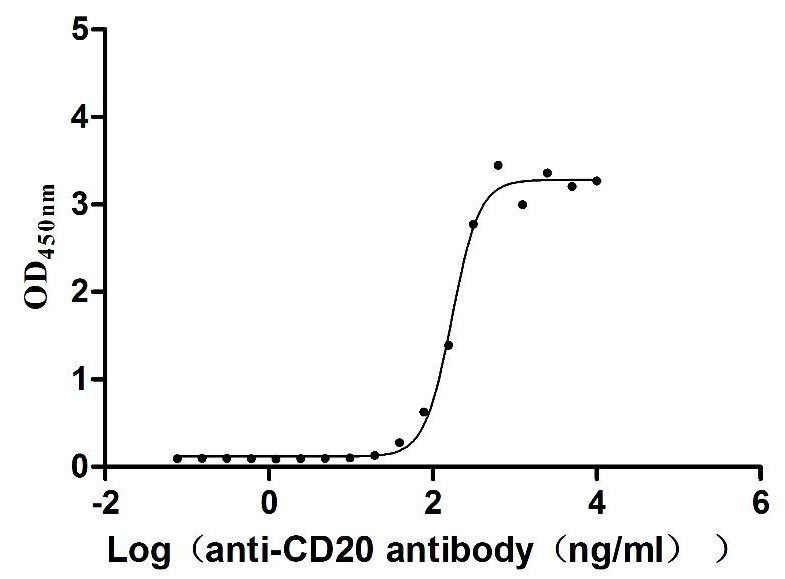Recombinant Human CMP-N-acetylneuraminate-poly-alpha-2,8-sialyltransferase (ST8SIA4), partial
-
中文名称:人ST8SIA4重组蛋白
-
货号:CSB-YP821630HU
-
规格:
-
来源:Yeast
-
其他:
-
中文名称:人ST8SIA4重组蛋白
-
货号:CSB-EP821630HU-B
-
规格:
-
来源:E.coli
-
共轭:Avi-tag Biotinylated
E. coli biotin ligase (BirA) is highly specific in covalently attaching biotin to the 15 amino acid AviTag peptide. This recombinant protein was biotinylated in vivo by AviTag-BirA technology, which method is BriA catalyzes amide linkage between the biotin and the specific lysine of the AviTag.
-
其他:
-
中文名称:人ST8SIA4重组蛋白
-
货号:CSB-BP821630HU
-
规格:
-
来源:Baculovirus
-
其他:
-
中文名称:人ST8SIA4重组蛋白
-
货号:CSB-MP821630HU
-
规格:
-
来源:Mammalian cell
-
其他:
产品详情
-
纯度:>85% (SDS-PAGE)
-
基因名:ST8SIA4
-
Uniprot No.:
-
别名:ST8SIA4; PST; PST1; SIAT8D; CMP-N-acetylneuraminate-poly-alpha-2,8-sialyltransferase; EC 2.4.99.-; Alpha-2,8-sialyltransferase 8D; Polysialyltransferase-1; Sialyltransferase 8D; SIAT8-D; Sialyltransferase St8Sia IV; ST8SiaIV
-
种属:Homo sapiens (Human)
-
蛋白长度:Partial
-
蛋白标签:Tag type will be determined during the manufacturing process.
The tag type will be determined during production process. If you have specified tag type, please tell us and we will develop the specified tag preferentially. -
产品提供形式:Lyophilized powder
Note: We will preferentially ship the format that we have in stock, however, if you have any special requirement for the format, please remark your requirement when placing the order, we will prepare according to your demand. -
复溶:We recommend that this vial be briefly centrifuged prior to opening to bring the contents to the bottom. Please reconstitute protein in deionized sterile water to a concentration of 0.1-1.0 mg/mL.We recommend to add 5-50% of glycerol (final concentration) and aliquot for long-term storage at -20℃/-80℃. Our default final concentration of glycerol is 50%. Customers could use it as reference.
-
储存条件:Store at -20°C/-80°C upon receipt, aliquoting is necessary for mutiple use. Avoid repeated freeze-thaw cycles.
-
保质期:The shelf life is related to many factors, storage state, buffer ingredients, storage temperature and the stability of the protein itself.
Generally, the shelf life of liquid form is 6 months at -20°C/-80°C. The shelf life of lyophilized form is 12 months at -20°C/-80°C. -
货期:Delivery time may differ from different purchasing way or location, please kindly consult your local distributors for specific delivery time.Note: All of our proteins are default shipped with normal blue ice packs, if you request to ship with dry ice, please communicate with us in advance and extra fees will be charged.
-
注意事项:Repeated freezing and thawing is not recommended. Store working aliquots at 4°C for up to one week.
-
Datasheet :Please contact us to get it.
相关产品
靶点详情
-
功能:Catalyzes the polycondensation of alpha-2,8-linked sialic acid required for the synthesis of polysialic acid (PSA), which is present on the embryonic neural cell adhesion molecule (N-CAM), necessary for plasticity of neural cells.
-
基因功能参考文献:
- Different properties of polysialic acids synthesized by the polysialyltransferases ST8SIA2 and ST8SIA4 have been described. PMID: 28810663
- our results demonstrate that miR-146a and miR-146b promote proliferation, migration and invasion of FTC via inhibition of ST8SIA4. PMID: 28427206
- Data show that miR-181c was inversely correlated with the levels of ST8SIA4 expression in chronic myelocytic leukemia (CML) cell lines and samples. PMID: 27527856
- This is the first report to demonstrate a role for a glycosyltransferase in human pluripotent stem cell lineage specification. PMID: 27074314
- changes in the glycosylation patterns and sialylation levels may be useful markers of the progression of breast cancer, as well as miR-26a/26b may be widely involved in the regulation of sialylation machinery by targeting ST8SIA4. PMID: 28032858
- The polybasic region of the polysialyltransferase ST8Sia-IV binds directly to NCAM. PMID: 28233978
- Sequence Requirements for Neuropilin-2 Recognition by ST8SiaIV and Polysialylation of Its O-Glycans. PMID: 26884342
- ST8SIA4 gene is involved in the development of multidrug resistance via PI3K/Akt pathway in chronic myeloid leukemia. PMID: 25855199
- this study indicated that sialylation involved in the development of MDR of AML cells probably through ST3GAL5 or ST8SIA4 regulating the activity of PI3K/Akt signaling and the expression of P-gp and MRP1. PMID: 24531716
- ST8SiaIV synthesized polySia selectively on a NRP2 glycoform that was characterized by the presence of sialylated core 1 and core 2 O-glycans. PMID: 23801331
- The ST8SiaIV/PST polybasic region plays a critical role in substrate recognition. PMID: 22184126
- polysialylated NCAM persistence, up-regulated polysialyltransferase-1 mRNA and previously uncovered defective myelin-associated glycoprotein may be early pathogenetic events in adult-onset autosomal-dominant leukodystrophy PMID: 19725832
- SIAT8D has a role in neural development and sialic acid synthesis on NCAM PMID: 12138100
- Pancreatitis risk was highest in individuals with abnormalities in pancreatic duct(CFTR) and acini (PST1) indicating that PST1 is a modifier gene for CFTR-related idiopathic chronic pancreatitis. PMID: 12227654
- The upregulation of ST8SIA4 and the donwregulation of ST8SIA2 by valproic acid in HUVEC and tumor cell lines are reported. PMID: 15710344
- polysialyltransferase ST8Sia IV/PST recognizes specific amino acids in the first fibronectin type III repeat of the neural cell adhesion molecule PMID: 16027151
- PSA-NCAM and ST8Sia-II/IV Expression Is Increased in Pancreatic Carcinomas PMID: 18384787
- Amino acid substitutions in conserved sequences are critical for the protein-specific polysialylation of NCAM. PMID: 19336400
显示更多
收起更多
-
亚细胞定位:Golgi apparatus membrane; Single-pass type II membrane protein.
-
蛋白家族:Glycosyltransferase 29 family
-
组织特异性:Highly expressed in fetal brain, lung and kidney and in adult heart, spleen and thymus. Present to a lesser extent in adult brain, placenta, lung, large and small intestine and peripheral blood leukocytes.
-
数据库链接:
HGNC: 10871
OMIM: 602547
KEGG: hsa:7903
STRING: 9606.ENSP00000231461
UniGene: Hs.308628
Most popular with customers
-
Recombinant Human Tumor necrosis factor receptor superfamily member 1A (TNFRSF1A), partial (Active)
Express system: Mammalian cell
Species: Homo sapiens (Human)
-
Recombinant Human Tumor necrosis factor ligand superfamily member 8 (TNFSF8), partial (Active)
Express system: Mammalian cell
Species: Homo sapiens (Human)
-
Recombinant Human Glucagon receptor (GCGR), partial (Active)
Express system: Mammalian cell
Species: Homo sapiens (Human)
-
Recombinant Human C-X-C chemokine receptor type 4 (CXCR4)-VLPs (Active)
Express system: Mammalian cell
Species: Homo sapiens (Human)
-
Recombinant Dog B-lymphocyte antigen CD20 (MS4A1)-VLPs (Active)
Express system: Mammalian cell
Species: Canis lupus familiaris (Dog) (Canis familiaris)
-
Express system: Mammalian cell
Species: Homo sapiens (Human)
-
Recombinant Human Dickkopf-related protein 1 (DKK1) (Active)
Express system: Mammalian cell
Species: Homo sapiens (Human)
-
Recombinant Human Cadherin-17 (CDH17), partial (Active)
Express system: Mammalian cell
Species: Homo sapiens (Human)





-AC1.jpg)


-AC1.jpg)









